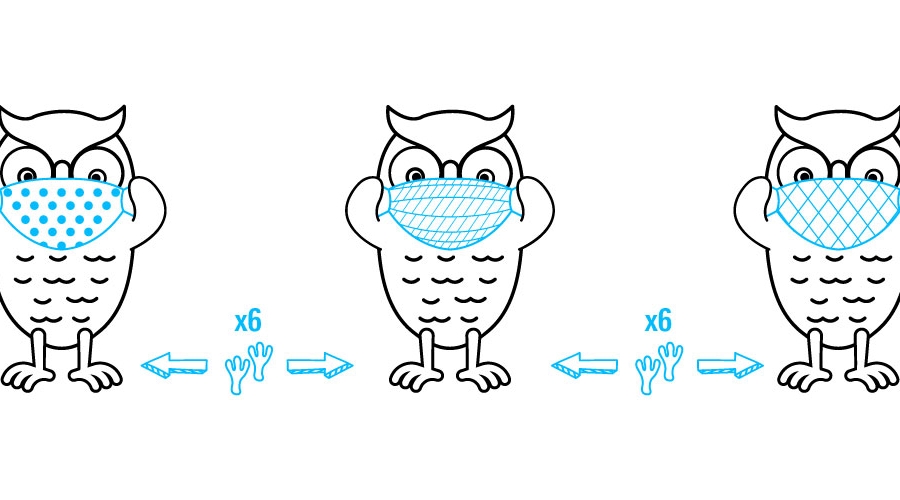
Since the COVID-19 pandemic caused the closure of Otis College’s campus last spring, the administration, faculty, and staff have worked non-stop to deliver the art and design education for which the College is known, but in the safest way possible for students. Instructors have found innovative ways to virtually engage students in their making practices while also fostering a sense of community in their online classrooms. Frederick Fisher and Partners and Ehrlich Yanai Rhee Chaney Architects, the two architecture firms that most recently designed the Residence Hall and Anne Cole buildings, regrouped with Otis faculty and senior leadership to prepare the campus for the eventual return of students, accounting for safe, social distancing, enhanced cleaning protocols, and the flow of foot traffic, among other considerations.
Likewise, the Campus Life division, which includes Residence Life and Housing and the Student Health and Wellness Center (SHWC), worked closely to devise the Fall 2020 Housing Plan, a set of guidelines and screening measures to ensure the health and safety of over 150 students, and 11 Resident Assistants, who have been living in the Park West and Ascent apartment buildings. The careful planning and implementation of these precautions during the pandemic has resulted in a zero percent positivity rate for COVID-19 among the College’s residential population. In simpler terms: no one living in campus housing has contracted COVID-19. When compared to stories at other California campuses that have had outbreaks of the virus, Otis’s zero percent positivity rate is a true achievement and is emblematic of the collaborative effort between staff and students.
“While there are guidelines we have implemented and a certain level of control we have among our residential students, we also realize we cannot control everything, but a zero percent positivity rate within our residential student population has been a very nice development for us all,” says Nick Negrete, Dean of Student Affairs.
How has Otis maintained this zero percent positivity rate among housing students? For starters, housing spaces were cut by 50 percent to ensure all rooms were single-occupancy, with shared bathrooms and living spaces. When outside their bedroom, students must wear face coverings and maintain six feet of distance from each other. There’s a strict No Guest Policy prohibiting residential students from having guests inside their apartment or suite that are not assigned to that specific space. They must do daily symptom tracking using the Coverified app—which the SHWC can monitor—and they undergo biweekly screening tests, also through the SHWC. The PCR tests used by the SHWC involve inserting cotton swabs a half-inch into each nostril, with results coming in 24 to 48 hours. “Surveillance testing is essential to preemptively catch cases before an outbreak occurs. If we can find positive cases in an asymptomatic population, we can prevent an outbreak from occurring,” says Dr. Julie Spencer, Director of the Student Health and Wellness Center.
Residential students were sent the guidelines, which were added to the Hallway Handbook, reviewed in Orientation videos, and posted on fliers in each room. Students also were asked to sign an addendum to their housing agreement that outlined the COVID-19 parameters. Once school commenced, students have been given constant messaging, reminders, education, and follow-up about the guidelines. “Students found in violation of these policies are referred to the student conduct process,” says Morgan Brown, Director of Residence Life and Housing. “These guidelines are key to helping keep the community safe, so we are taking any violation very seriously.” Other disciplinary measures include probation, conduct hearings, and even phone calls to parents and families.
“They can assist us in delivering that message as a key partner in our plan to keep students as safe as possible,” says Negrete.
Brown worked in tandem with Dr. Spencer to develop the Fall 2020 Housing Plan, which will continue to be implemented this spring. The basis for the plan came from the weekly Campus Life COVID-19 Task Force meetings that started in early spring 2020, as well as biweekly phone calls that Dr. Spencer and the SHWC staff have with the Los Angeles County Department of Public Health.
“We knew that as the pandemic evolved and changed we would need to be nimble and flexible, so we created many scenarios and policies to make sure we were proactive and thinking ahead to minimize any reactive response we would need to make,” says Laura Kiralla, Vice President of Campus Life, who attributes the success of the zero percent positivity rate to Otis’s students. “Students have taken the pandemic seriously, they have cared deeply for their peers, and, for the most part, are doing their best to adhere to all mandated requirements.”
MarcAnthony Pellici Smith, a sophomore who also is a Resident Advisor, appreciates the work that the Campus Life team has put towards his and other students’ safety. “The constant testing has helped ease my own anxiety about the pandemic,” he says. “Using the Coverified app has become an extremely quick and simple step in my day and doesn’t interfere with anything else in my life. I completely understand any concerns someone would have about residing on campus, but Otis Housing really is taking every precaution possible to prevent any outbreaks. I believe the zero percent positivity rate represents that well.”
Izzy Adelina De Paz, a junior Resident Advisor, concurs. “I know we still have to be careful, but I can prioritize my studies and not worry as much about everyone around me because of the precautions everyone has to take to live in housing,” she says. “It does help ease the anxieties that I had when coming to live in housing, but it also helps me to keep doing my part to stay at that zero percent.”
Information about Otis College’s housing options for spring 2021 can be found at otis.edu/housing-residence-life.
Illustration by Khang Nguyen (’21 Communication Arts, Graphic Design).


